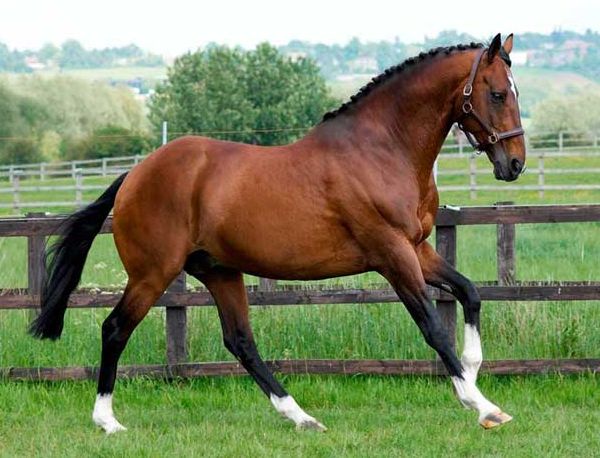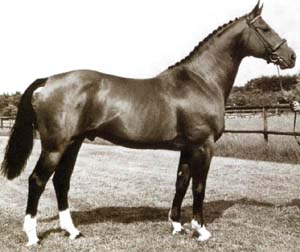The Anglo-Norman horse was a warmblood horse breed developed in Lower Normandy in northern France. A major center of horse breeding, the area had numerous regional types that were bred to one another and then crossed with Thoroughbreds to form the Anglo-Norman.
Various body types developed within the Anglo-Norman breed, two of which were split off to form the Norman Cob and French Trotter. The remaining types were eventually standardized, although there remained some criticism of the “hybrid” nature of the breed’s conformation. However, it was successful as an international sport horse, especially in the sport of show jumping. The Anglo-Norman also contributed to the development of several other breeds in Europe and Asia.

The Anglo-Norman was developed in the early 19th century, and along with Thoroughbred and local Norman blood, influences were seen from other breeds, including British and Russian trotting horses. By the mid-19th century, the Anglo-Norman was a popular breed throughout France, and in 1864 a breed association was founded.
While often purchased by the French army and used as cavalry and artillery horses, there was controversy over whether the Anglo-Norman was the best choice for the military. The late 19th century saw significant improvements in breeding programs, although there remained a dispute between the goals of breeders and the needs of the military.
Mechanization in the early 20th century significantly reduced demand for the breed, and fighting during World War II and the German occupation of France resulted in major damage to breeding centers and the deaths of many horses. While rebuilding their herds, breeders turned away from draft and carriage horses and began breeding sport horses for equestrian competition.
A stud book was created for the Anglo-Norman in 1950, and during that decade the breed became successful in international competition. In 1958, the Anglo-Norman was combined with other French types to create the Selle Français, the national French saddle horse. Despite active government support for Selle Français breeding programs, variations remained, and Anglo-Norman bloodlines continued to be distinguishable for decades after the merge.
 The golden bay Anglo-Norman stallion Almé Z, pictured at left, was a phenomenon. Without ever having stood at stud in Germany, the 1966 French born Ibrahim son influenced almost all the German warmblood breeds from the Belgian model studfarm of Zangersheide.
The golden bay Anglo-Norman stallion Almé Z, pictured at left, was a phenomenon. Without ever having stood at stud in Germany, the 1966 French born Ibrahim son influenced almost all the German warmblood breeds from the Belgian model studfarm of Zangersheide.
Before he went to stud in Belgium, he had already performed covering duty at his French home and left inter alia the approved sons Galoubet, I love you and Jalisco, all of whom have played a role in international showjumping. Almé Z was himself a successful international showjumper with Francois Mathy and Johan Heins and transmitted his gift for jumping lavishly to his progeny.
The overwhelming number of Zangersheide products carried the Hanoverian brand. However despite the fact that two of the three Almé Z sons standing in Holstein had Hanoverian dams, the Holstein Association, which otherwise looks askance at any form of extraneous blood, did not hesitate to avail themselves of the Almé Z blood. Almé Z was one of the most significant sires of the twentieth century and most certainly the first who deserves the title of “Euro-stallion.”
In the 1990s and 2000s, a movement began to reopen the Anglo-Norman stud book and recreate it as a separate breed from the Selle Français. The plan, which remains open, has been presented to the French Stud Book Commission and Ministry of Agriculture, and created controversy within the French breeding community.
Breed characteristics of the Anglo-Norman horse breed
The conformation of the Anglo-Norman reflected its multiple influences. By 1861, the French government attempted to standardize the look of various historic Norman horse types by adding large amounts of Thoroughbred blood. The resulting offspring gave rise to the Anglo-Norman. However, in spite of these breeding programs, by 1909 when author Alfred Gallier studied the Anglo-Norman, he described members of the breed as “hybrids from various crosses”. He distinguished three types: trotting horses used for harness racing, carriage horses, and military horses. He subdivided the military type further into heavy cavalry, light cavalry, “cavalry of the line” (a specific type used by the French) and artillery horses.
Anglo-Norman trotters were the fastest in France, and were reputed to be patient and hard-working.
The first official trotting races in France took place in 1836, in Cherbourg, at the instigation of Ephrem Houël, an officer of the National Stud. He believed that trotting races were the best way to select breeding stock for producing saddle horses.
The best of the Anglo-Norman trotting horses emerged between 1820 and 1870, with five major stallions becoming the foundation bloodstock for the French Trotter breed, which officially split from the Anglo-Norman breed in 1906. The continuing breeding goal of the Anglo-Norman was to maintain a balanced breed with input from Thoroughbred stallions and heavier mares of the original Norman type.
By 1966, the Anglo-Norman breed had been further standardized and was described as averaging 15.1 to 16.3 hands (61 to 67 inches, 155 to 170 cm) high, although sometimes taller. The facial profile was convex, the neck long, and the shoulders and hindquarters powerful.
The breed had a tendency to have a too-upright shoulder angle and one author still criticized the horses as “… [consisting] of two inharmonious and badly united pieces, one being Norman; the other, English”, suggesting that better results would occur if breeders used higher-quality broodmares. Despite this criticism, Anglo-Normans were known for their jumping abilities, with many successful horses competing at the international level.
Influence of the Anglo-Norman on other breeds
The Anglo-Norman was used to create several other breeds of horses throughout Europe and Asia. These included the Greek Andravida, which was created by crossing native Greek mares with Anglo-Norman stallions, and the Swiss Freiberger, a blend of Anglo-Norman lines with Thoroughbreds and native horses from the Jura Mountains.
The Hungarian Nonius breed stems from an Anglo-Norman stallion named Nonius Senior, and Anglo-Norman blood was also used to add refinement to the German Oldenburg, through the stallions Condor (born 1950) and Furioso II, a Selle Français. The Anglo-Norman was used to create the Polish Sokolsky horse and the Chinese Heihe breed.
